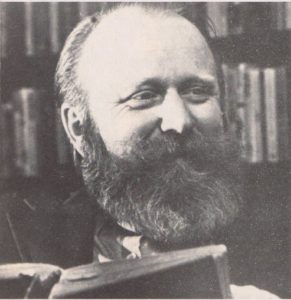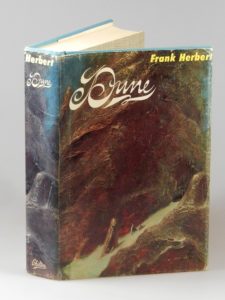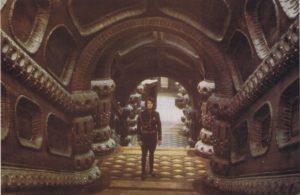In 1965, two works changed the face of genre publishing forever. Ace Books that year came out with an unauthorized paperback edition of an obscure decade-old fantasy trilogy called The Lord of the Rings, written by a pipe-smoking old Oxford don named J.R.R. Tolkien, and promptly sold hundreds of thousands of copies of it. And the very same year, Chilton Books, a house better known for its line of auto-repair manuals than for its fiction, became the publisher of last resort for Frank Herbert’s epic science-fiction novel Dune. While Dune‘s raw sales weren’t initially quite so impressive as those of The Lord of the Rings, it was recognized immediately by science-fiction connoisseurs as the major work it was, winning its year’s Nebula and Hugo Awards for Best Novel (the latter award alongside Roger Zelazny’s This Immortal).
It may be that you can’t judge a book by its cover, but you can to a large extent judge the importance of The Lord of the Rings and Dune by their thickness. Genre novels had traditionally been slim things, coming in at well under 300 pocket-sized mass-market-paperback pages. These two novels, by contrast, were big, sprawling works. The writing on their pages as well was heavier than the typical pulpy tale of adventure. Tolkien’s and Herbert’s novels felt utterly disconnected from trends or commercial considerations, redolent of myth and legend — sometimes, as plenty of critics haven’t hesitated to point out over the years, rather ponderously so. At a stroke, they changed readers’ and publishers’ perception of what a fantasy or science-fiction novel could be, and the world of genre publishing has never looked back.
In the years since 1965, almost as much has been written of Dune as The Lord of the Rings. Still, it’s new to us. And so, given that it suddenly became a very important name in computer games circa 1992, we should take the time now to look at what it is and where it came from.
At the time of Dune‘s publication, Frank Herbert was a 45-year-old newspaperman who had been dabbling in science fiction — his previous output had included one short novel and a couple of dozen short stories — since the early 1950s. He had first been inspired to write Dune by, appropriately enough, sand dunes. Eight years before the novel’s eventual publication, the San Francisco Examiner, the newspaper for which he wrote, sent him to Florence, Oregon, to write about government efforts to control the troublesomely shifting sand dunes just outside of town. It didn’t sound like the most exciting topic in the world, and, indeed, he never managed to turn it into an acceptable article. Yet he found the dunes themselves weirdly fascinating:
I had far too much for an article and far too much for a short story. So I didn’t know really what I had—but I had an enormous amount of data and avenues shooting off at all angles to get more… I finally saw that I had something enormously interesting going for me about the ecology of deserts, and it was, for a science-fiction writer anyway, an easy step from that to think: what if I had an entire planet that was desert?
The other great spark that led to Dune wasn’t a physical environment, nor for that matter a physical anything. It was a fascination with the messiah complex that has been with us through all of human history, even though it has seldom, Herbert believed, led us to much good. Somehow this theme just seemed to fit with a desert landscape; think of the Biblical Moses and the Exodus.
I had this theory that superheroes were disastrous for humans, that even if you postulated an infallible hero, the things this hero set in motion fell eventually into the hands of fallible mortals. What better way to destroy a civilization, society, or race than to set people into the wild oscillations which follow their turning over their judgment and decision-making faculties to a superhero?
Herbert worked on the novel off and on for years. Much of his time was spent in pure world-building — or, perhaps better said in this case, galaxy-building — creating a whole far-future history of humanity among the stars that would inform and enrich any specific stories he chose to set there; in this sense once again, his work is comparable to that of J.R.R. Tolkien, that most legendary of all builders of fantastic worlds. But his actual story mostly took place on the desert planet Arrakis, also known as Dune, the source of an invaluable “spice” known as melange, which confers upon humans improved health, longer life, and even paranormal prescience, while also allowing some of them to “fold space,” thus becoming the key to interstellar travel. As the novel’s most popular and apt marketing tagline would put it, “He who controls the spice controls the universe!” The spice has made this inhospitable world, where water is so scarce that people kill one another over the merest trickle of the stuff, whose deserts are roamed by gigantic carnivorous sandworms, the most valuable piece of real estate in the galaxy.
The novel centers on a war between two great trading houses, House Atreides and House Harkonnen, for control of the planet. The politics involved, not to mention the many military and espionage stratagems they employ against one another, are far too complex to describe here, but suffice to say that Herbert’s messiah figure emerges in the form of the young Paul Atreides, who wins over the nomadic Fremen who have long lived on Arrakis and leads them to victory against the ruthless Harkonnen.
Dune draws heavily from any number of terrestrial sources — from the Old Testament of the Christian Bible, from the more mystical end of Zen Buddhism, from the history of the Ottoman Empire and the myths and cultures of the Arab world. Nevertheless, the whole novel has an almost aggressively off-putting otherness about it. Herbert writes like a native of his novel’s time and place would, throwing strange jargon around with abandon and doing little to clarify the big-picture politics of the galaxy. And he shows no interest whatsoever in explaining that foremost obsession of so many other science-fiction writers, the technology and hardware that underpin his story. Like helicopters and diving suits to a writer of novels set in our own time and place, “ornithopters” and “stillsuits,” not to mention interstellar space travel, simply are to Dune‘s narrator. Meanwhile some of the bedrock philosophical concepts that presumably — hopefully! — unite most of Dune‘s readership — such ideas as fundamental human rights and democracy — don’t seem to exist at all in Herbert’s universe.
This wind of Otherness blowing through its pages makes Dune a famously difficult book to get started with. Those first 50 or 60 pages seem determined to slough off as many readers as possible. Unless you’re much smarter than I am, you’ll need to read Dune at least twice to come to anything like a full understanding of it. All of this has made it an extremely polarizing novel. Some readers love it with a passion; some, like yours truly here, find it easier to admire than to love; some, probably the majority, wind up shrugging their shoulders and walking away.
In light of this, and in light of the way that it broke every contemporary convention of genre fiction, beginning but by no means ending with its length, it’s not surprising that Frank Herbert found Dune to be a hard sell to publishers. The tropes were familiar enough in the abstract — a galaxy-spanning empire, interstellar war, a plucky young hero — but the novel, what with its lofty, affectedly formal prose, just didn’t read like science fiction was supposed to. Whilst allowing what amounted to a rough draft of the novel to appear in the magazine Analog Science Fiction in intermittent installments between December 1963 and May 1965, Herbert struggled to find an outlet for it in book form. The manuscript was finally accepted by Chilton only after being rejected by over twenty other publishers.
Those other publishers would all come to regret their decision. Dune took some time to gain traction with readers outside science fiction’s intelligentsia; Herbert didn’t make enough money from his fiction to quit his day job until 1969. But the oil embargoes of the 1970s gave this novel that was marked by such Otherness an odd sort of social immediacy, winning it many readers outside the still fairly insular community of written science fiction, making it a trendy book to have read or at least to say you had read. For many, it now read almost like a parable; it wasn’t hard to draw parallels between Arrakis’s spice and our own planet’s oil, nor between the Fremen of Arrakis and the cultures native to our own planet’s great oil-rich deserts. As critic Gwyneth Jones puts it, Dune is, among other things, a depiction of “scarcity, and the kind of human culture that scarcity produces.” It was embraced by many in the environmentalist movement, who read it it as a cautionary tale perfect for an era in which we earthbound humans were being forced to confront the reality that our planet’s resources are not infinite.
So, Dune eventually sold a staggering 12 million copies, becoming by most accounts the best-selling work of genre science fiction in history. And so we arrive at one final parallel to The Lord of the Rings: that of a book that was anything but an easy read in the conventional sense nevertheless selling in quantities to rival any beach-and-airport time-waster ever written. Umberto Eco’s The Name of the Rose was famously described at the height of its 1980s popularity as a book that everyone owned and almost no one had ever managed to get all the way through. Dune may very well be the closest equivalent in genre fiction.
Herbert wrote five sequels to Dune, none of which are as commonly read or as highly regarded among critics as the first novel. [1]As for the flood of more recent Dune novels, written by Frank Herbert’s son Brian Herbert and Kevin J. Anderson, previously a prolific author of X-Files and Star Wars novels and other low-hanging fruit of the literary landscape: stay far, far away. One might say, however, that the second and third novels at least — Dune Messiah (1969) and Children of Dune (1976) — are actually necessary to appreciate Herbert’s original conception of the work in its entirety. He had always conceived of Dune as an epic tragedy in the Shakespearean sense, but reading the first book alone can obscure this fact. That book is, as the science-fiction scholar Damien Broderick puts it, typical pulp science fiction in at least one sense: it satisfies “an adolescent craving for an imaginary world in which heroes triumph by a preternatural blend of bravery, genius, and sci.” It’s only in the second and third books that Paul Atreides, the messiah figure, begins to fail, thus illustrating how a messiah can, as Herbert says, “destroy a civilization, society, or race.” That said, it would be the first novel alone with which almost all media adaptations would concern themselves, so it will also monopolize our attention in these articles.
Dune‘s success was such that it inevitably attracted the interest of the film industry. In 1972, the British producer Arthur P. Jacobs, the man behind the hugely successful Planet of the Apes films, acquired the rights to the series, but he had the misfortune to die the following year, before his plans had gotten beyond the storyboarding phase.
Yet Dune‘s trendiness only continued to grow, and interest in turning it into a film remained high among people who wouldn’t have been caught dead with any other science-fiction novel. In 1974, the rights passed from Jacob’s estate to Alejandro Jodorowsky, a transgressive Chilean director who claimed to once have raped one of his actresses in the name of his Art. Manifesting an alarming obsession with the act, he now planned to do the same to Frank Herbert:
It was my Dune. When you make a picture, you must not respect the novel. It’s like you get married, no? You go with the wife, white, the woman is white. You take the woman, if you respect the woman, you will never have child. You need to open the costume and to… to rape the bride. And then you will have your picture. I was raping Frank Herbert, raping, like this! But with love, with love.
The would-be rape victim could only look on in disbelief: “He had so many personal, emotional axes to grind. I used to kid him, ‘Well, I know what your problem is, Alejandro. There is no way to horsewhip the pope in this story.'”
Jodorowsky planned to fill the cast and crew of the film, which would bear an estimated price tag of no less than $15 million, with flotsam washed up from the more dissipated end of the celebrity pool: Orson Welles, Gloria Swanson, Charlotte Rampling, Salvador Dali, Mick Jagger, Alain Delon. But, even in this heyday of Porno Chic, no one was willing to entrust such an erratic personality with such a budget, and the project fizzled out after Jodorwsky had blown through $2 million on scripts, concept art, and the drugs that were needed to fuel it all.
In the meantime, the possibilities for cinematic science fiction were being remade by a little film called Star Wars. Indeed, said film bears the clear stamp of Dune, especially in its first act, which takes place on a desert planet where water is the most precious commodity of all. And certainly the general dirty, lived-in look of Star Wars, so distinct from the antiseptic futures of most science fiction, owes much to Dune.
In the wake of Star Wars, Dino De Laurentiis, one of the great impresarios of post-war Italian cinema, acquired the rights to Dune from Jodorowsky’s would-be backers. He secured a tentative agreement with Ridley Scott, who was just finishing his breakthrough film Alien, to direct the picture. Rudy Wurlitzer, screenwriter of the classic western Pat Garrett and Billy the Kid, wrote three drafts of a script, but the financing necessary to begin production proved hard to secure. Thus in 1981 the cinematic rights to Dune, which Herbert had sold away for a span of nine years to Arthur P. Jacobs back in 1972, finally reverted to the author after their extended but fruitless world tour.
Yet De Laurentiis remained passionate about his Dune film — so much so that he immediately entered into negotiation with Herbert to reacquire the rights. Having watched various filmmakers come close to doing unspeakable things to his creation over the previous decade — even Wurlitzer’s recent script reportedly added an incest plot line involving Paul Atreides and his mother — Herbert insisted that he must at least be given the role of “advisor” to any future film. De Laurentiis agreed to this.
He was so eager to make a deal because Dune had suddenly looked to be back on, for real this time, just as the rights were expiring. His daughter, Raffaella De Laurentiis, had taken on the Dune film as something of a passion project of her own. She was riding high with a brand of blockbuster-oriented, action-heavy fare that was quite different from the films of her father’s generation. She was already in the midst of producing Conan the Barbarian, starring a buff if nearly inarticulate former bodybuilding champion named Arnold Schwarzenegger; it would become a major hit, launching Schwarzenegger’s career as Hollywood’s go-to action hero over the next couple of decades. But the Dune project would be a different sort of beast, a sort of synthesis of father and daughter’s priorities: a big-budget film with an art-film sensibility. For Ridley Scott had by this time moved on to other projects, and Dino and Raffaella De Laurentiis had a surprising new candidate in mind to direct their Dune.
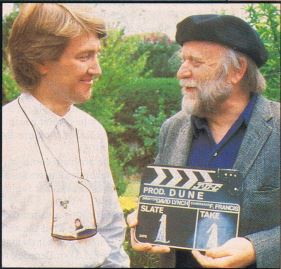
David Lynch and Frank Herbert. Interviewers were constantly surprised at how normal Lynch looked and acted in person, in contrast to his bizarre films. Starlog magazine, for example, wrote of his “sculptured hair [and] jutting boyish features,” saying he was “extremely polite and well-mannered, the antithesis of enigma. Not a hint of phobic neurosis or deep-seated sexual maladjustment.”
David Lynch was already a beloved director of the art-film circuit, although his output to date had consisted of just two low-budget black-and-white movies: Eraserhead (1977), a surrealistic riot of a horror film, and The Elephant Man (1980), a mournful tragedy of prejudice and isolation. He would seem to stand about as far removed from the family-friendly fare of George Lucas and Steven Spielberg’s new Hollywood as it was possible to get. And yet that mainstream of filmmakers saw something — something having to do with his talent for striking, kinetic visuals — in the 36-year-old director. In fact, Lucas actually asked him whether he would be interested in directing the third Star Wars film, Return of the Jedi, whereupon Lynch rather peremptorily turned the offer down, saying he wasn’t interested in making sequels to other people’s films. But when Dino De Laurentiis approached him about Dune he was more receptive. Lynch:
Dino’s office called me and asked if I had ever read Dune. I thought they said “June.” I never read either one of ’em! But once I got the book, it’s like when you hear a new word. And I started hearing it more often. Then, I began finding out that friends of mine had already read it and freaked out over it. It took me a long time to read. Actually, my wife forced me to read it. I wasn’t that keen on it at first, especially the first 60 pages. But the more I read, the more I liked. Because Dune has so many things that I like, I said, “This is a book that can be made into a film.”
Lynch joined screenwriters Eric Bergen and Christopher De Vore for a week at Frank Herbert’s country farmhouse, where they hammered out a script which ran to a hopelessly overlong 200 pages. As the locale would indicate, Herbert was involved in the creative process, but kept a certain distance from the details: “This is a translation job. I wouldn’t presume to be the person who should translate Dune from English to French; my French is execrable. It’s the same with a movie; you go to the person who speaks ‘movie.'”
The script was rewritten again and again in the months that followed, the later drafts by Lynch alone. (He would be given sole credit as the screenwriter of the finished film.) In the process, it slimmed down to a still-ambitious 135 pages. And with that, and with the De Laurentiis father and daughter having lined up a positively astronomical amount of financing from Universal Pictures, who were desperate for a big science-fiction franchise of their own to rival 20th Century Fox’s Star Wars and Paramount’s Star Trek, a real Dune film finally got well and truly underway.
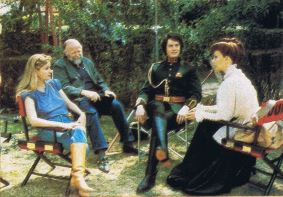
Raffaella De Laurentiis and Frank Herbert with the actors Kyle MacLachlan and Francesca Annis on the set of Dune, 1983.
Rehearsals and pre-production began in the Sonora Desert outside of Mexico City in October of 1982; actual shooting started the following March, and dragged on over many more months. In the lead role of Paul Atreides, Lynch had cast a 25-year-old Shakespearean-trained stage actor named Kyle MacLachlan, who had never acted before a camera in his life. Nor, at six feet tall and 155 pounds, was he built much like an action hero. But he was trained in martial arts, and he gave it his all over a long and difficult shoot.
Joining him were a number of recognizable character actors, such as the intimidating Swede Max von Sydow, cast in the role of the Fremen leader Kynes, and the villain specialist Kenneth McMillan, all but buried under 200 pounds of fake silicone flesh as the disgustingly evil — or evilly disgusting — Baron Vladimir Harkonnen. Patrick Stewart, later to become famous in the role of Star Trek: The Next Generation‘s Captain Jean-Luc Picard, played Paul’s martial mentor Gurney Halleck. In a bit of stunt casting, Sting of the rock band the Police, deemed “biggest band in the world” by any number of contemporary critics, took the role of one of the supporting cast of villains — a role which would, naturally, be blown out of all proportion by the movie’s promoters. To a person, everyone involved with the shoot remembers it as being uncomfortable at best. “I was taxed on almost every level as a human being,” says MacLachlan. “Mexico City is not one of the most pleasant spots in the world to be.” The one thing they all mention is the food poisoning; almost everyone among cast and crew got it at one time or another, and some lived with it for the entirety of the months on end they spent in Mexico.
Universal Pictures had given David Lynch, this young director who was used to shooting on a shoestring budget, an effective blank check in the hope that it would yield the next George Lucas and/or the next Star Wars. Lynch didn’t hesitate to spend their money, building some eighty separate sets and shooting hundreds of hours of footage. Even in Mexico, where the peso was cheap, it added up. Universal would later claim an official budget of $40 million, but rumblings inside Hollywood had it that the real total was more like $50 million. Either figure was more than immense enough to secure Dune the title of most expensive Universal film ever. (For comparison’s sake, consider that the contemporary big-budget blockbusters Return of the Jedi and Indiana Jones and the Temple of Doom cost approximately $40 million and $30 million respectively.)
The shoot had been difficult enough in itself, but the film first began to show the telltale signs of a doomed production only in the editing phase, as Lynch tried to corral his reams of footage into a finished product. He clashed repeatedly with Raffaella De Laurentiis and Universal, both of whom made it clear that they expected a relatively “clean,” PG-rated film with a coherent narrative through line for their money. Such qualities weren’t, of course, what David Lynch was known for. But the director had failed to secure final-cut rights to the film, and he was repeatedly overridden. Finally, he all but removed himself from the process altogether, and Raffaella De Laurentiis herself cobbled together much of the finished film, going so far as to shoot her own last-minute bridging scenes whilst layering clumsy voice-overs and internal monologues over the top, all in a (failed) effort to make the labyrinthine plot comprehensible to a casual audience. Meanwhile Universal continued to spew forth a fountain of hype about “Star Wars for adults” and “the end of the pulp era of science-fiction movies,” whilst continuing to plaster Sting, looking fetching in his black leather, across their “Coming Attractions” posters and trailers as if he was the star. Dune was set for a fall.
And, indeed, the finished product, which arrived in theaters in December of 1984, provided a rare opportunity for every corner of movie fandom and criticism to unite in hatred. The professional critics, most of whom had never read the book, found the film, even with all the additional expository voice-overs, as incomprehensible as Raffaella De Laurentiis had always feared they would. Fans of the novel had the opposite problem, bemoaning the plot simplification and the liberties taken with the story, complaining about the way that all of the thematic texture had been lost in favor of Lynchian weirdness for weirdness’s sake. And the all-important general audience, for their part, stayed away in droves, making Dune one of the more notorious flops in cinematic history. Just like that, Universal Pictures’s dream of a Star Wars franchise of their own went up in smoke.
Seen today, free of the hype and the resultant backlash, the film isn’t as bad as many remember it; many of its scenes are striking in that inimitable Lynchian way. But it doesn’t hang together at all as a holistic experience, and its best parts are often those that have the least to do with its source material. Many over the years have suspected that there’s a good film hidden somewhere in all that footage Lynch shot, if it could only be freed from the strictures of the two-hour running time demanded by Universal; Lynch’s own first rough cut, they point out, was reportedly at least twice that long. Yet various attempts to rejigger the material — including a 1988 version for television that ballooned the running time to more than three hours — haven’t yielded results that feel all that much more holistically satisfying than the original theatrical cut. The film remains what it was from the first, a strange hybrid stranded in a no-man’s land between an art film and a conventional blockbuster, not really working as either. At bottom, the film reflects a hopeless mismatch between its director and its source material. What happens when you ask a brilliant director with very little interest in plot to film a novel famous for its intricate plot? You get a movie like David Lynch’s Dune. Perhaps the kindest thing one can say about it is that it is, unlike so many of Hollywood’s other more misbegotten projects, an interesting failure.
Lynch disowned the film almost immediately. He’s generally refused to talk about it at all in interviews since 1984, beyond dismissing it as a “sell-out” on his part. The one positive aspect of the film which even he will admit to is that it brought Kyle MacLachlan to his attention. The latter starred in Lynch’s next film as well, the low-budget psychological-horror picture Blue Velvet (1986), which rehabilitated its director’s critical reputation at a stroke at the same time that it marked the definitive end of his brief flirtation with mainstream sensibilities. MacLachlan would go on to find his most iconic role as the weirdly impassive FBI agent Dale Cooper in Lynch’s supremely weird television series Twin Peaks.
The Dino de Laurentiis Corporation had invested everything they had and then some in their Dune film. They went bankrupt in the aftermath of its failure — but, in typical corporate fashion, a phoenix known as the De Laurentiis Entertainment Group soon emerged from the ashes. Just to show there were no hard feelings, one of the reincarnated production company’s first films was David Lynch’s Blue Velvet.
Surprisingly in light of the many readers who complained so vociferously about the liberties the Dune film took with his novel, Frank Herbert himself never disowned it, speaking of it quite warmly right up until his death. But sadly, that event came much earlier than anyone had reckoned it would: he died in 1986 at age 65, the victim of a sudden blood clot in his lung that struck just after he had undergone surgery for prostate cancer.
Dune did come to television screens in 2000, in a rather workmanlike miniseries adaptation that was more comprehensible and far more faithful to the novel than Lynch’s film, but which lacked the budget, the acting talent, or the directorial flair to rival its predecessor as an artistic statement. Today, almost half a century after Arthur P. Jacobs first began to inquire about the film rights, the definitive cinematic Dune has yet to be made.
There is, however, one other sort of screen on which Dune has undeniably left a profound mark: not the movie or even the television screen, but the monitor screen. It’s in that direction that we’ll turn our attention next time.
(Sources: the books The Cambridge Companion to Science Fiction, edited by Edward James and Farah Mendlesohn and Frank Herbert by Timothy O’Reilly; Starlog of January 1983, May 1984, October 1984, November 1984, December 1984, February 1985, and June 1986; Enter of December 1984; the online articles “Jodorowsky’s Dune Didn’t Get Made for a Reason… and We Should All Be Grateful For That” and “David Lynch’s Dune is What You Get When You Build a Science Fictional World With No Interest in Science Fiction” by Emily Asher-Perrin.)
Footnotes
| ↑1 | As for the flood of more recent Dune novels, written by Frank Herbert’s son Brian Herbert and Kevin J. Anderson, previously a prolific author of X-Files and Star Wars novels and other low-hanging fruit of the literary landscape: stay far, far away. |
|---|
